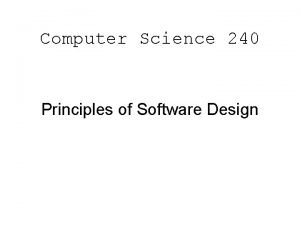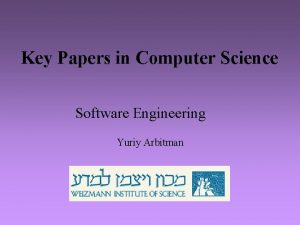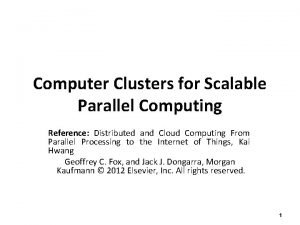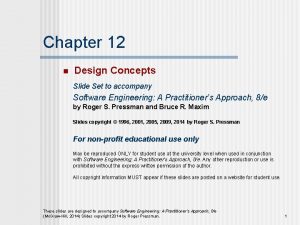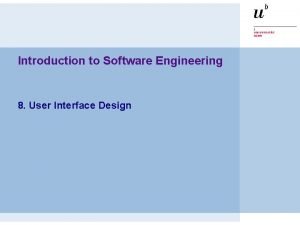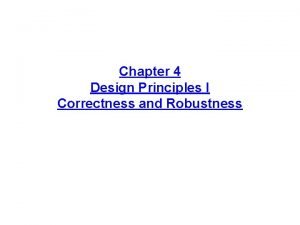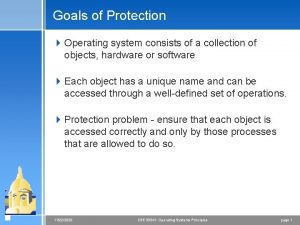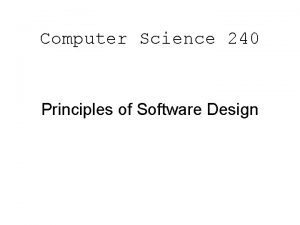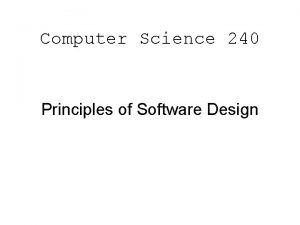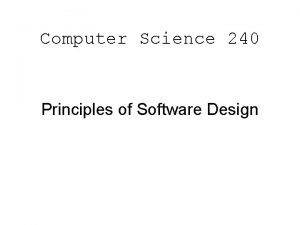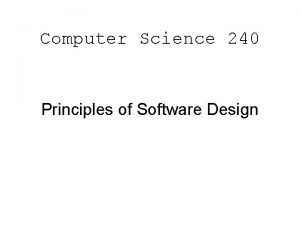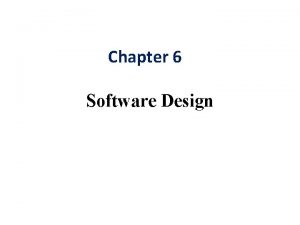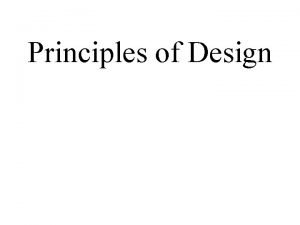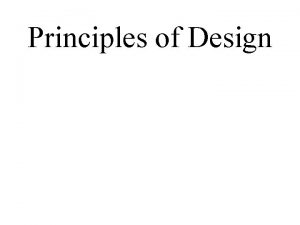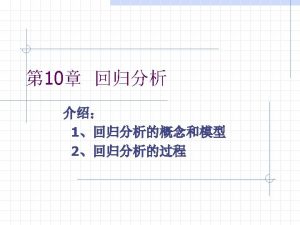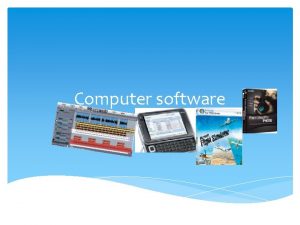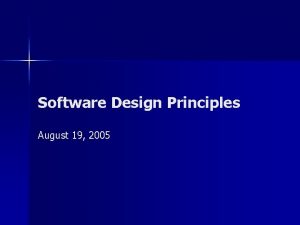Computer Science 240 Principles of Software Design Goals




















- Slides: 20

Computer Science 240 Principles of Software Design

Goals of Software Design • Create systems that – – Work Easy as possible to understand, debug, and maintain Hold up well under changes Have reusable components

Design is inherently iterative • Design, implement, test, … • Feedback loop from implementation back into design provides valuable knowledge • Designing everything before beginning implementation doesn’t work • Beginning implementation without doing any design also doesn’t work • The appropriate balance is achieved by interleaving design and implementation activities in relatively short iterations

Abstraction • Abstraction is one of the software designer’s primary tools for coping with COMPLEXITY • Programming languages and OSes provide abstractions that model the underlying machine • Programs written solely in terms of these low-level abstractions are very difficult to understand • Software designers must create higher-level, domainspecific abstractions, and write their software in terms of those – High-level abstractions implemented in terms of low-level abstractions

Abstraction • Some abstractions correspond to “real world” concepts in the application domain – Examples: Bank, Customer, Account, Loan, Broker, … • Other abstractions do not correspond to “real world” domain concepts, but are needed for internal implementation – Examples: Http. Server, Database, Hash. Table, …

Abstraction • Each abstraction is represented as a class • Each class has a carefully designed public interface that defines how the rest of the system interacts with it • A client can invoke operations on an object without understanding how it works internally • This is a powerful technique for reducing the cognitive burden of building complex systems

Naming • A central part of abstraction is giving things names (or identifiers) • Selecting good names for things is critical • Class, method, and variable names should clearly convey their function or purpose • Class and variable names are usually nouns • Method names are usually verbs – Exceptions • Object properties (ID, Name, Parent, etc. ) • Event handlers (Mouse. Moved, User. Logged. In)

Cohesion / Single Responsibility • Each abstraction should have a single responsibility • Each class should represent one, well-defined concept – All operations on a class are highly related to the class’ concept • Each method should perform one, well-defined task – Unrelated or loosely related tasks should be in different methods • Cohesive classes and methods are easy to name

Abstracting All the Way • Some abstractions are simple enough to store directly using the language’s built-in data types – Name => string – Pay Grade => int – Credit Card => string • Often it is best to create classes for such simple abstractions for the following reasons: – Data validation – Related operations – Code readability

Decomposition • In addition to Abstraction, Decomposition is the other fundamental technique for taming COMPLEXITY • Large problems subdivided into smaller subproblems • Subdivision continues until leaf-level problems are simple enough to solve directly • Solutions to sub-problems are recombined into solutions to larger problems

Decomposition • Decomposition is strongly related to Abstraction • The solution to each sub-problem is encapsulated in its own abstraction (class or subroutine) • Solutions to larger problems are concise because they’re expressed in terms of sub-problem solutions, the details of which can be ignored • The decomposition process helps us discover (or invent) the abstractions that we need

Decomposition • Levels of decomposition – – – System Subsystem Packages Classes Routines • Hypo- and Hyper-Decomposition • When have we decomposed far enough? – Size metrics – Complexity metrics – Single responsibility

Algorithm & Data Structure Selection • No amount of decomposition or abstraction will hide a fundamentally flawed selection of algorithm or data structure.

Minimize Dependencies • Dependencies – Class A CALLS Class B – Class A HAS MEMBER OF Class B – Class A INHERITS FROM Class B

Minimize Dependencies • Minimizing the number of interactions between different classes has several benefits: – A class with few dependencies is easier to understand – A class with few dependencies is less prone to ripple effects – A class with few dependencies is easier to reuse

Minimize Dependencies • When classes must interact, if possible they should do so through simple method calls – This kind of dependency is clear in the code and relatively easy to understand

Separation of Interface and Implementation • Maintain a strict separation between a class’ interface and its implementation • This allows internal details to change without affecting clients • interface Stack + class Stack. Impl • Program to interfaces instead of concrete classes

Information Hiding • Many languages provide “public”, “private”, and “protected” access levels • All internal implementation is “private” unless there’s a good reason to make it “protected” or “public” • A class’ public interface should be as simple as possible

Information Hiding • Don’t let internal details “leak out” of a class – Class. Rollinstead of Student. Linked. List • Some classes or methods are inherently tied to a particular implementation. For these it is OK to use an implementation-specific name – Hash. Table – Tree. Set

Code Duplication • Code duplication should be strenuously avoided – Identical or similar sections of code • Disadvantages of duplication: – N copies to maintain – Bugs are duplicated N times – Makes program longer, decreasing maintainability • Solutions – Factor common code into a separate method or class – Shared code might be placed in a common superclass
 Strategic goals tactical goals operational goals
Strategic goals tactical goals operational goals Strategic goals tactical goals operational goals
Strategic goals tactical goals operational goals Computer design goals
Computer design goals His favourite subject is
His favourite subject is Ap csp sequencing
Ap csp sequencing General goals and specific goals
General goals and specific goals Examples of generic goals and product-specific goals
Examples of generic goals and product-specific goals Software engineer vs software developer
Software engineer vs software developer Computer science software engineering
Computer science software engineering Computer science software engineering
Computer science software engineering Design principles of computer clusters
Design principles of computer clusters Principles of computer input and output design
Principles of computer input and output design Software design fundamentals in software engineering
Software design fundamentals in software engineering Design principles in software engineering
Design principles in software engineering User interface design principles in software engineering
User interface design principles in software engineering Software design principles correctness and robustness
Software design principles correctness and robustness What is basic computer organization
What is basic computer organization Principles of design in interior design ppt
Principles of design in interior design ppt Real time software design in software engineering
Real time software design in software engineering What are protection goals and principles
What are protection goals and principles Goals of audio lingual method
Goals of audio lingual method


